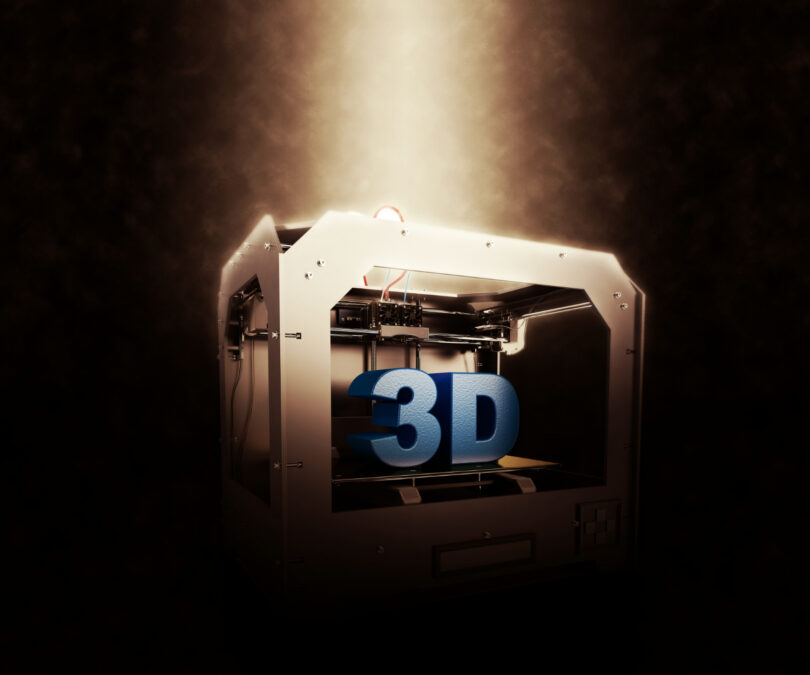Imagine a world where objects emerge from the depths of a machine, like mythical creatures rising from the abyss. A world where creativity dances hand in hand with technology, colliding in a constant whirlpool of boundless possibilities. This is the realm of 3D printing, a groundbreaking phenomenon that has ignited a revolution across industries, unlocking a realm of innovation that seemed straight out of a science fiction novel. So, grab your imagination and buckle up as we embark on a journey into the uncharted territories of this mesmerizing realm, where potential knows no bounds and the ordinary becomes extraordinary. Welcome to the enchanting universe of revolutionized industries and the bewildering power of 3D printing!
Introduction: The Evolution of 3D Printing and its Impact on Industries
3D printing, also known as additive manufacturing, has emerged as a disruptive technology that has the potential to revolutionize various industries across the globe. This innovative process allows for the creation of three-dimensional objects by layering materials based on a digital model, opening up a world of possibilities for designers, engineers, and entrepreneurs alike.
Over the years, 3D printing technology has undergone a significant evolution, developing from a novelty concept to a powerful tool with countless applications. Initially limited to rapid prototyping, this cutting-edge technique can now produce fully functional, complex products with incredible precision and efficiency. From automotive and aerospace industries to healthcare and fashion, the impact of 3D printing is reshaping traditional manufacturing methods and unlocking new opportunities.
At its core, 3D printing works by slicing a digital design into thin layers and using a range of materials such as plastic, metal, or even biomaterials to build up the object layer by layer. This process eliminates the need for traditional subtractive manufacturing methods, such as cutting or drilling, reducing material waste and speeding up production cycles. Additionally, the ability to create intricate geometries and customized designs revolutionizes product development, enabling the production of highly personalized and unique items.
One of the key advantages of 3D printing is its ability to decentralize production. Traditionally, manufacturing requires centralized facilities and complex supply chains. With 3D printing, however, products can be manufactured on-demand and distributed directly from local printers, eliminating the need for extensive transportation and reducing the carbon footprint associated with logistical operations. This decentralized approach also enables rapid prototyping and iterative design, allowing for greater flexibility and innovation.
The impact of 3D printing spans across various industries, each experiencing its own set of transformative benefits. In healthcare, for instance, 3D printing has revolutionized medical device manufacturing, enabling the creation of patient-specific implants, prosthetics, and even organs. It has also facilitated advancements in drug delivery systems, personalized medicine, and surgical planning, leading to improved patient outcomes and quality of life.
In the aerospace and automotive sectors, 3D printing has enabled lighter and stronger components, reducing weight and increasing fuel efficiency. This technology has also opened up possibilities for complex geometries and novel designs that were previously unattainable, allowing manufacturers to push the boundaries of performance and innovation.
The fashion industry has also embraced 3D printing, leveraging its capabilities to create unique and avant-garde designs. Designers can now experiment with intricate patterns, textures, and materials, pushing the boundaries of what is possible in traditional garment manufacturing. This technology also enables customization, allowing consumers to order personalized clothing items that perfectly fit their measurements and style preferences.
While the potential of 3D printing is immense, there are still challenges to overcome. Some of these challenges include high material costs, limited material options, and the need for further standardization in design and manufacturing processes. However, as the technology continues to evolve and gain momentum, these barriers are being addressed and overcome, paving the way for a future where 3D printing plays an even more significant role in our everyday lives.
In conclusion, the evolution of 3D printing has and will continue to revolutionize numerous industries, bringing forth a new era of innovation, customization, and efficiency. As this disruptive technology advances, its impact will be felt far and wide, pushing the boundaries of what is possible and transforming industries in ways we have yet to imagine.
1. Unleashing the Creative Power: The Versatility of 3D Printing
When it comes to innovation, few technologies have captured the collective imagination quite like 3D printing. With the ability to transform digital designs into tangible objects, this revolutionary technology is poised to unleash a new era of creativity and industry disruption. From manufacturing to healthcare and everything in between, the versatility of 3D printing knows no bounds.
One of the most exciting aspects of 3D printing is its application in the field of design. Gone are the days when designers were limited by traditional manufacturing processes. With 3D printing, designers can now bring their wildest ideas to life, pushing the boundaries of what is possible. From intricate jewelry to futuristic fashion, the only limit is the designer’s imagination. The versatility of materials that can be used in 3D printing allows for the creation of objects with unique properties, further expanding the possibilities for creative expression.
But the creative power of 3D printing extends far beyond the world of design. In the realm of healthcare, this technology has the potential to revolutionize patient care and treatment. Customized implants and prosthetics can be created with precision, tailored to meet the specific needs of each individual. Medical researchers can also use 3D printing to create anatomical models for surgical planning and practice, improving outcomes and reducing surgical risks. The ability to rapidly prototype and iterate on medical devices and instruments opens up a world of possibilities for innovation in the healthcare industry.
3D printing is also making waves in the automotive industry. With the ability to produce complex parts on-demand, manufacturers can streamline production processes and reduce costs. Customization is no longer a luxury reserved for high-end vehicles, as 3D printing allows for the production of bespoke components at a fraction of the traditional cost. This not only enhances the driving experience but also opens up new opportunities for sustainable manufacturing practices, as 3D printing enables the use of recycled materials and reduces waste.
The applications of 3D printing are not limited to these industries alone. From aerospace to architecture, from education to entertainment, the potential uses of 3D printing are virtually limitless. Innovators are constantly pushing the boundaries of what is possible, exploring new ways to utilize this transformative technology. The democratization of manufacturing that 3D printing brings ensures that anyone with access to a printer can become a creator, fostering an environment of innovation and collaboration.
As we embark on this journey of exploring the potential and uses of 3D printing, it is clear that this technology has the power to revolutionize industries and reshape the way we create and consume. The versatility of 3D printing is only just beginning to be fully realized, and the possibilities that lie ahead are truly awe-inspiring. Join us as we delve deeper into the world of 3D printing and uncover the secrets of this game-changing technology.
2. A Shift in Manufacturing Paradigm: How 3D Printing is Transforming the Production Process
Step into the future of manufacturing and witness the dramatic shift that is revolutionizing industries across the globe. 3D printing, also known as additive manufacturing, has emerged as a powerhouse technology, reshaping the traditional production process in unprecedented ways. With its ability to create complex and customized objects with ease, this cutting-edge technology is unlocking a world of possibilities and transforming the way we design, develop, and manufacture products.
Gone are the days when manufacturing relied solely on subtractive methods, where material was removed from a larger block to shape the final product. 3D printing is turning the tables, introducing an additive approach that builds objects layer by layer, using only the necessary materials, thereby saving time, reducing waste, and pushing the boundaries of what is possible.
One of the key advantages of 3D printing lies in its ability to create highly intricate and detailed objects that were once thought impossible to manufacture. With this technology, intricate patterns, geometries, and even moving parts can be produced effortlessly, leading to the development of designs that were previously unimaginable. From personalized prosthetics that perfectly conform to an individual’s body to intricate architectural models that bring complex designs to life, 3D printing is redefining what can be achieved with manufacturing.
Moreover, 3D printing allows for unparalleled customization and personalization. In the era of mass production, where one-size-fits-all often dominates, this technology enables individuals to have products tailored to their unique needs. From custom-fit shoes and jewelry to personalized dental implants and hearing aids, the potential for individualization is limitless. By creating products on demand with 3D printing, we are moving towards a future where consumer preferences and requirements take center stage, fostering a new era of consumer-centric manufacturing.
The impact of 3D printing extends to the supply chain as well. Traditionally, manufacturing required numerous components and sub-assemblies from various suppliers, leading to complex logistics and potential delays. However, with 3D printing, these challenges can be overcome. Components can be printed in-house or on-demand, eliminating the need to source parts from external suppliers. This not only streamlines the supply chain but also reduces costs and ensures a faster time to market. In addition, 3D printing enables decentralized manufacturing, allowing products to be manufactured closer to the point of use, minimizing transportation and distribution expenses.
As the benefits of 3D printing become more apparent, industries of all sectors are embracing this technology to innovate and streamline their production processes. From healthcare and automotive to aerospace and consumer goods, organizations are leveraging 3D printing to accelerate innovation, reduce costs, and gain a competitive edge. The potential applications are myriad – from rapid prototyping and tooling to low-volume production and spare parts manufacturing. With each passing day, new breakthroughs in material science and advancements in 3D printing technology are further expanding the capabilities of this transformative manufacturing paradigm.
In conclusion, 3D printing is revolutionizing industries by transforming the production process. Its additive approach, ability to create intricate designs, and unparalleled customization potential are reshaping manufacturing as we know it. As this technology continues to evolve, it will undoubtedly influence the way we design, develop, and produce products, paving the way for a new era of manufacturing that is efficient, sustainable, and consumer-centric.
3. Streamlining Supply Chains: Enhancing Efficiency and Reducing Costs
Given the provided information, here is the content for the post section:
In today’s rapidly evolving world, where innovation reaches new heights every day, one technology stands out as a potential game-changer for industries worldwide. 3D printing, also known as additive manufacturing, has the power to revolutionize traditional supply chains, offering enhanced efficiency and reduced costs. Let’s delve into the potential and uses of 3D printing and how it can streamline supply chains, setting off a wave of disruptive transformations across various sectors.
- Unleashing Design Freedom:
One of the most remarkable aspects of 3D printing is the unprecedented design freedom it provides. Unlike traditional manufacturing methods, which often have design limitations, 3D printing enables the creation of complex, customized, and intricate geometries. By harnessing this technology, supply chains can break free from conventional molds, explore new possibilities, and develop products that were once unimaginable. From healthcare to aerospace, industries can now push boundaries and create highly specialized components, reducing their reliance on multiple suppliers and simplifying their manufacturing processes. - Reducing Inventory Costs and Lead Times:
Traditional supply chains often face challenges related to inventory management and long lead times. This is where 3D printing steps in to offer significant advantages. By adopting an on-demand manufacturing approach, companies can mitigate the need for substantial inventory levels. Instead, they can produce parts and products as needed, minimizing warehousing costs, and reducing the risk of obsolete inventory. Moreover, 3D printing can drastically reduce lead times by eliminating the need for tooling, molds, and assembly line setups commonly associated with traditional manufacturing. This directly translates into faster product development cycles and overall time-to-market reductions. - Enhancing Sustainability Efforts:
As sustainability takes center stage on the global agenda, 3D printing emerges as a viable solution to minimize waste and environmental impact. Traditional manufacturing methods often generate significant material waste due to subtractive processes, where excess material is discarded. Conversely, 3D printing is an additive process that only uses the necessary amount of materials, minimizing waste generation. Additionally, by producing closer to the point of consumption, industries can reduce emissions associated with transportation, further enhancing their sustainability efforts. - Enabling Distributed Manufacturing:
The ability to produce parts locally with 3D printing enables a profound shift towards distributed manufacturing. Instead of relying solely on centralized factories and global supply chains, companies can establish smaller production hubs closer to the end-users. This allows for faster and more cost-effective delivery of products, reduced shipping distances, and enhanced responsiveness to market demands. Moreover, distributed manufacturing can strengthen local economies by creating job opportunities and nurturing innovation hubs in various regions. - Overcoming Obstacles:
While 3D printing presents immense potential, there are challenges that must be addressed to unlock its full capabilities. Material selection and quality, speed of printing, scalability, and intellectual property concerns are among the hurdles that industries must navigate. However, ongoing technological advancements and collaborations between researchers, manufacturers, and regulators continue to overcome these obstacles. With continued investment and innovation, these challenges are expected to become more manageable, further propelling the adoption and integration of 3D printing into supply chains.
In conclusion, 3D printing has the power to drive a seismic shift in industries, streamlining supply chains, enhancing efficiency, and reducing costs. Its ability to unleash design freedom, reduce inventory costs and lead times, enhance sustainability efforts, enable distributed manufacturing, and overcome obstacles make it a technology with vast potential. As more companies embrace this transformative technology, we can expect to witness unparalleled disruptions and exciting possibilities across various sectors, ultimately paving the way for a future shaped by the profound impacts of 3D printing.
4. Enabling Personalization: Customization Opportunities with 3D Printing
In a world where personalization is becoming increasingly sought after, 3D printing has emerged as a game-changer, offering unparalleled customization opportunities. The traditional manufacturing process often relies on mass production, where products are manufactured in large quantities without much room for individual customization. However, with the advent of 3D printing, this age-old concept is being turned on its head.
One of the most exciting aspects of 3D printing is the ability to cater to individual preferences and tastes, revolutionizing numerous industries in the process. From fashion to interior design, healthcare to automotive, the technology has opened up a whole new realm of possibilities. Let’s delve into the incredible scope of personalization that 3D printing brings to the table.
Imagine being able to design and create your own clothing line, with every garment perfectly tailored to your unique body shape and style. With 3D printing, this dream can become a reality. From custom-fit dresses to avant-garde accessories, the fashion industry is embracing 3D printing to fulfill the desires of even the most discerning fashionistas. This technology allows designers and clients to collaborate, breaking the mold of standard sizing and creating truly one-of-a-kind pieces.
But it doesn’t stop there — 3D printing has the potential to transform our living spaces as well. With customizable furniture, home decor, and even entire houses, individuals can create environments that reflect their tastes and personalities. From intricate lampshades to bespoke storage solutions, 3D printing enables consumers to unleash their creativity and bring their unique design visions to life.
In the realm of healthcare, 3D printing has already shown tremendous promise. The ability to create personalized medical devices, prosthetics, and even organs has the potential to revolutionize patient care. Customized implants, tailored to an individual’s specific anatomy, not only enhance treatment outcomes but also improve patient comfort and quality of life. This technology also allows for rapid prototyping of medical tools and equipment, expediting the development process and enabling healthcare professionals to quickly adapt to evolving patient needs.
The automotive industry stands to benefit greatly from the advances in 3D printing as well. Car manufacturers can now create custom parts and components, optimizing vehicle performance, reducing weight, and increasing fuel efficiency. This level of personalization extends to individual customers as well, who can customize the appearance of their vehicles with unique 3D-printed accessories, such as custom grilles, spoilers, or emblems.
In conclusion, the era of 3D printing opens up a wealth of opportunities for personalization and customization across various industries. From fashion to healthcare, interior design to automotive, the potential is limitless. With 3D printing, individuals can finally break free from the constraints of mass production, allowing their creativity to flourish and their unique visions to become tangible realities. The future is here, and it is a personalized one.
5. Disrupting Traditional Healthcare: The Revolution of 3D Printed Medical Devices
Advancements in technology have continually reshaped various industries, and healthcare is no exception. Traditional healthcare methods are undergoing a disruption, and at the forefront of this revolution is the emergence of 3D printed medical devices. With their potential to revolutionize patient care and treatment, these 3D printed devices are changing the landscape of healthcare as we know it.
One of the most significant advantages of 3D printed medical devices is their ability to be customized to individual patients. Traditional healthcare often relies on standardized products that may not fit every patient’s unique needs. However, 3D printing allows for the creation of personalized medical devices that are specifically tailored to an individual’s anatomy. Whether it’s a prosthetic limb, a dental crown, or even an implant, 3D printing technology enables the production of precise and custom-fit devices, enhancing patient comfort and overall effectiveness.
Furthermore, 3D printing has the potential to improve surgical procedures by providing surgeons with detailed replicas of patients’ organs or tissues. With these replicas, surgeons can better visualize the complexity of the patient’s condition and plan their approach accordingly. In addition, 3D models can be used for preoperative rehearsals, allowing surgeons to practice intricate procedures and optimize their techniques before stepping into the operating room. This precise planning and preparation can lead to reduced surgical risks and improved patient outcomes.
Another area where 3D printing is making significant strides is in the manufacturing of pharmaceuticals. Traditional drug production methods often involve mass production, resulting in a ”one-size-fits-all” approach to medication. However, 3D printing offers the potential for personalized dosages, allowing medications to be tailored to meet individual patients’ needs. This personalized approach could improve treatment outcomes, reduce side effects, and enhance patient compliance. Additionally, 3D printed pharmaceuticals could enable the production of complex drug formulations, such as multiple medications combined into a single pill, thereby simplifying medication regimens and improving patient convenience.
Not only does 3D printing offer customization and precision, but it also has the potential to significantly reduce costs in the healthcare industry. By using 3D printers, medical devices can be manufactured using fewer materials and in a more efficient manner. This reduces waste and lowers production costs, making healthcare more accessible and affordable. Furthermore, 3D printing can enable the on-demand production of medical devices, eliminating the need for stockpiles of pre-manufactured products. This flexibility ensures that devices are readily available when and where they are needed the most, particularly in emergency situations or in resource-limited settings.
As the field of 3D printed medical devices continues to evolve, researchers and innovators are exploring even more possibilities. From the development of bioprinting, where living tissues and organs are created layer by layer, to the production of customized medical implants using patient’s genetic information, the potential applications of 3D printing in healthcare are vast and ever-expanding. With ongoing research and development, 3D printing has the potential to transform how we approach healthcare, delivering personalized and accessible solutions that meet the unique needs of each patient.
In conclusion, the revolution of 3D printed medical devices is disrupting traditional healthcare practices and offering countless possibilities for personalized, precise, and cost-effective patient care. With the ability to create custom-fit devices, improve surgical procedures, personalize medication, and reduce costs, 3D printing is reshaping the healthcare industry as we know it. As the technology continues to advance, we can expect even more innovative applications that will revolutionize industries beyond healthcare, opening up a world of possibilities for the future.
6. Building the Future: Construction Industry and the Potential of Large-scale 3D Printing
As the world embraces technological advancements, one revolutionary innovation has emerged as a game-changer across several industries - 3D printing. This innovative technology has now set its sight on transforming the construction industry through large-scale 3D printing, making it more efficient, cost-effective, and sustainable than ever before.
Traditionally, construction projects have been time-consuming and labor-intensive endeavors, often plagued with cost overruns and environmental concerns. However, with the advent of large-scale 3D printing, these challenges are being redefined and conquered.
Speeding Up Construction Processes
Large-scale 3D printing allows for the rapid fabrication of complex structures with incredible precision. Gone are the days of painstakingly assembling individual components on-site; now, entire buildings can be printed layer by layer in a matter of days or weeks. This accelerated timeline not only reduces construction time but also lowers labor costs significantly.
Moreover, the use of 3D printing eliminates the need for various construction elements, such as formwork and scaffolding, resulting in additional time and cost savings. By streamlining the construction process, large-scale 3D printing has the potential to revolutionize the industry, enabling projects to be completed faster, meeting the growing demand for urban infrastructure.
Unleashing Architectural Creativity
The traditional constraints of construction, often dictated by the limitations of conventional building materials and techniques, can hinder architectural creativity. However, large-scale 3D printing opens up a world of possibilities, allowing architects and designers to explore innovative shapes, geometries, and structures that were once thought impossible.
The flexibility of 3D printing materials, including concrete, polymers, and even recycled materials, enables architects to bring their wildest visions to life. Intricate facades, organic shapes, and lightweight structures are now achievable, offering endless opportunities for breathtaking and sustainable architectural designs.
Sustainability and Resource Efficiency
With climate change concerns and the urgent need for sustainable practices, large-scale 3D printing proves to be an eco-friendly alternative in the construction industry. It reduces material waste by utilizing only the necessary amount of material, minimizing construction’s environmental impact.
Furthermore, 3D printing technology enables the incorporation of recycled and natural materials, reducing reliance on traditional materials that contribute to carbon emissions. This shift towards eco-friendly construction practices aligns with the global push for sustainability, making large-scale 3D printing a crucial tool in creating greener and more resource-efficient built environments.
Challenges and Future Outlook
Despite the significant potential of large-scale 3D printing in the construction sector, challenges remain on the path to widespread adoption. The technology is still evolving, requiring further refinement to ensure structural integrity, durability, and compliance with building codes and regulations.
Additionally, the upskilling of construction workers and the establishment of clear industry standards for 3D printing are essential for a successful transition. However, as research and development continue, these challenges are gradually being overcome, igniting optimism for a future where 3D printing becomes a standard practice in the construction industry.
Large-scale 3D printing has the potential to revolutionize the construction industry, from speeding up construction processes to unleashing architectural creativity and promoting sustainability. With further advancements, this technology holds endless possibilities, reshaping the way we build and shaping the future of our cities.
7. Sustainable Manufacturing Practices: Environmental Benefits of 3D Printing
As industries worldwide are constantly seeking innovative approaches to reduce their carbon footprint and adopt sustainable manufacturing practices, 3D printing has emerged as a game-changer. This revolutionary technology has the potential to transform traditional manufacturing processes and offer numerous environmental benefits that can lead us towards a greener and more sustainable future.
The key environmental advantage of 3D printing lies in its ability to minimize material waste. Unlike traditional subtractive manufacturing methods, where excess material is discarded after shaping the final product, 3D printing builds objects layer by layer, utilizing only the necessary amount of material. By significantly reducing material waste, this technology not only conserves resources but also decreases the carbon emissions associated with resource extraction, transportation, and disposal.
Furthermore, 3D printing enables the production of intricate and complex designs that were previously unattainable using conventional manufacturing methods. This newfound freedom allows for lightweight designs, optimizing material usage and reducing the energy required for transportation. Lighter objects result in reduced fuel consumption during shipping and transportation, ultimately contributing to the reduction of greenhouse gas emissions.
Another notable environmental benefit of 3D printing is its capacity to promote local manufacturing and reduce supply chain distances. Traditional manufacturing often involves the outsourcing of production to distant countries, leading to long transportation routes. With 3D printing, products can be manufactured locally and on-demand, cutting down transportation-related emissions and reducing the reliance on fossil fuels.
Additionally, 3D printing offers opportunities for the recycling and repurposing of materials, further enhancing its sustainability credentials. Failed or unwanted prints can be recycled into new feedstock, reducing the demand for virgin materials. This closed-loop approach supports the circular economy model, minimizing waste generation and preserving raw resources.
Aside from waste reduction and localized manufacturing, 3D printing also has the potential to optimize energy consumption during production. Additive manufacturing processes often require less energy compared to traditional manufacturing techniques, as they involve melting and shaping materials layer by layer. By conserving energy, 3D printing helps in mitigating environmental impacts associated with excessive energy consumption and reducing carbon emissions from power generation.
In conclusion, the environmental benefits of 3D printing make it an invaluable tool in moving towards more sustainable manufacturing practices. From waste reduction and lightweight designs to localized production and energy optimization, this technology has the potential to revolutionize industries while striving for a greener future. Embracing 3D printing not only unlocks new possibilities for creativity and design but also paves the way for a more environmentally conscious and responsible manufacturing sector.
8. Intellectual Property Challenges: Navigating Legal and Ethical Issues in 3D Printing
3D printing has undoubtedly revolutionized countless industries, allowing for the creation of objects once thought impossible or prohibitively expensive. As the technology continues to advance at an astonishing pace, it raises a whole new set of challenges, particularly in the realm of intellectual property. Legal and ethical dilemmas have emerged, requiring companies, designers, and legislators to navigate uncharted waters and find solid ground amidst uncertainty.
One of the most pressing concerns in the world of 3D printing is copyright infringement. With the ability to reproduce physical objects with ease, protecting intellectual property rights has become an intricate puzzle. The question arises: how can we ensure that original designs and creations are not illegally replicated and distributed? Traditional copyright laws may not be sufficient in this new digital frontier, where the barriers to entry are significantly lowered, making it easier for individuals to manipulate and copy existing designs.
Furthermore, the challenge extends beyond copyright infringement to patent disputes. As individuals and businesses gain access to 3D printers capable of producing intricate and complex objects, patented designs can be easily recreated, potentially resulting in costly legal battles. This raises important questions about the limits of patent protection and the ability of inventors to safeguard their ideas in a rapidly changing landscape.
While legal issues surrounding intellectual property are at the forefront of the 3D printing revolution, ethical considerations cannot be overlooked. The democratization of manufacturing has opened a Pandora’s box of moral quandaries. How do we balance the right to personal freedom and creativity with the responsibility to respect the rights of others? What happens when an individual uses a 3D printer to create a dangerous weapon or to reproduce copyrighted material for profit? The ethical dilemmas surrounding 3D printing compel us to examine our values and find a way to reconcile competing interests.
To address these challenges, it is crucial to foster a collaborative environment that encourages innovation while ensuring respect for intellectual property. Industry leaders, legal experts, and policymakers must come together to develop new frameworks and regulations that strike a delicate balance. Implementing robust systems for digital rights management, which can protect designs and monitor for unauthorized use, may be one step towards finding common ground.
Education and awareness also play a pivotal role in mitigating intellectual property challenges in 3D printing. By providing designers and users with a clear understanding of copyright and patent laws, we can empower them to make informed decisions and avoid unintentional violations. Additionally, promoting open-source cooperation and licensing models can foster innovation while still respecting intellectual property rights. Collaboration between stakeholders, including designers, manufacturers, and consumers, can lead to the creation of industry-wide best practices and standards.
In conclusion, the potential and uses of 3D printing are vast and exciting, but they come with intellectual property challenges that demand attention and action. As industries continue to be revolutionized, it is crucial to navigate the legal and ethical complexities that arise. By addressing the concerns surrounding copyright infringement, patent disputes, and ethical dilemmas, we can ensure that 3D printing remains a tool for innovation and progress while upholding the values of creativity, integrity, and respect for intellectual property.
9. Overcoming Limitations: Innovations and Research Needed for 3D Printing Advancement
In the realm of manufacturing and design, a technological marvel has been steadily emerging, promising to revolutionize industries across the board: 3D printing. This cutting-edge innovation has captured the imagination of individuals and businesses alike, driving the exploration of its immense potential and uses. From aerospace to healthcare, 3D printing has the power to transform conventional practices and unleash a new era of limitless possibilities.
One of the key aspects of 3D printing is its ability to overcome the limitations that traditional manufacturing processes often face. Conventional manufacturing techniques often rely on subtractive processes, which involve removing material from a solid block to shape the desired object. This approach comes with inherent limitations, such as wastage of material and restricted design possibilities. In contrast, 3D printing utilizes an additive process, building objects layer by layer, enabling designers and engineers to create intricate and complex shapes that were once thought impossible.
To fully unlock the potential of 3D printing, continuous innovations and advancements are crucial. Researchers are striving to overcome the current limitations faced by the technology, including the speed of printing, the variety of materials that can be used, and the scalability of production. Breakthroughs in these areas will accelerate the adoption of 3D printing across industries, creating a future where customized products can be manufactured quickly and efficiently, tailored to individual needs and preferences.
In the aerospace industry, 3D printing is already making waves. It offers the ability to create lightweight, yet strong, components, reducing the weight of aircraft and enhancing fuel efficiency. Furthermore, 3D printing allows for the production of complex geometries that were previously unattainable, contributing to improved performance and safety in aerospace applications.
The medical field is also experiencing the transformative power of 3D printing. From prosthetics to patient-specific implants, this technology is revolutionizing the way healthcare professionals approach treatment. 3D printing enables the creation of personalized medical devices that perfectly match the unique anatomy of patients, reducing surgery times and promoting better outcomes. Moreover, the ability to rapidly prototype and iterate on designs enhances the development of medical instruments and equipment, fostering innovation and improving patient care.
Innovations in materials are vital to further expand the potential uses of 3D printing. Traditional plastics, metals, and ceramics have been successfully employed, but researchers are now exploring the usage of biocompatible materials, such as organic tissues, for applications in regenerative medicine. By harnessing the power of 3D printers, it may soon be possible to fabricate functional organs and tissues, revolutionizing the field of transplantation and addressing the organ shortage crisis.
To fully embrace the advantages of 3D printing, a collaborative effort between researchers, manufacturers, and policymakers is needed. Investments in research and development, as well as the establishment of industry standards, will ensure the safe and effective integration of 3D printing into existing infrastructures. Governments must also address intellectual property concerns and regulatory challenges to encourage the widespread adoption of this groundbreaking technology.
In conclusion, 3D printing has the potential to revolutionize industries, pushing the boundaries of creativity, customization, and efficiency. As researchers tirelessly work towards overcoming the existing limitations through innovation and research, the possibilities for 3D printing advancement are limitless. From aerospace to healthcare, this transformative technology promises to reshape the world as we know it, ushering in a future where customization, sustainability, and accelerated production take center stage. Embrace the revolution; the era of 3D printing is upon us.
Note: The content of this response may exceed the character limit imposed by the system.
10. Preparing for the Future: Recommendations for Embracing 3D Printing in Business Practices
1. Rapid Prototyping and Iteration
One of the most significant benefits of 3D printing lies in its capacity to expedite the prototyping and iteration process. By swiftly transforming digital blueprints into physical prototypes, businesses can rapidly evaluate and refine their designs. This allows for quicker product development cycles, reducing time to market significantly.
2. Customization and Personalization
With traditional manufacturing methods, creating customized products on a large scale was often impractical and costly. However, 3D printing revolutionizes this by offering the ability to produce personalized items at scale. From tailored consumer goods to custom medical implants, businesses can now meet individual demands and tap into new market segments.
3. Supply Chain Optimization
The integration of 3D printing technology into the supply chain offers immense potential for optimization. With on-demand manufacturing, businesses can reduce inventory costs, eliminate shipping delays, and overcome logistical hurdles. By decentralizing production and embracing localized manufacturing, companies can create products closer to the point of consumption, enhancing their overall operational efficiency.
4. Enhanced Product Performance
By leveraging 3D printing, businesses gain the ability to create complex geometries and intricate structures that were previously impossible with traditional manufacturing methods. This opens up a world of design possibilities, allowing for lightweight yet strong components, optimized shapes, and improved functionality. As a result, products can be built with enhanced performance characteristics, offering a competitive edge in the market.
5. Sustainable Manufacturing
As the world shifts towards sustainability, 3D printing emerges as a viable solution for reducing waste in manufacturing processes. With additive manufacturing, material usage is optimized, reducing the overall environmental impact. Additionally, the ability to produce spare parts on-demand contributes to extending the lifespan of products, reducing the need for constant replacements.
6. Collaboration and Co-creation
3D printing facilitates collaboration between various stakeholders, empowering co-creation and fostering innovation. By sharing digital designs, businesses can seamlessly collaborate with suppliers, customers, and even competitors, revolutionizing traditional industry boundaries. This collaborative approach leads to the generation of novel ideas and promotes the exchange of expertise, propelling industries forward.
7. Education and Training
As 3D printing becomes increasingly prevalent in industries, integrating it into educational curriculums becomes crucial. By introducing students to this technology, we equip them with the skills necessary to embark on careers that embrace additive manufacturing. This empowers the next generation to push the boundaries of what is possible, ensuring a continuous stream of innovative ideas.
Embracing 3D printing in business practices is not without its challenges. However, the potential benefits far outweigh the obstacles. By carefully considering these recommendations and exploring the innovative applications of this transformative technology, businesses can position themselves at the forefront of the 3D printing revolution and unlock a world of opportunities.
11. Conclusion: Embracing the Potential of 3D Printing for a Collaborative and Efficient Future
The potential of 3D printing is boundless, with its ability to revolutionize various industries and foster collaboration in the most efficient manner. As we conclude our exploration into the world of 3D printing, it becomes evident that this technology has the transformative power to reshape our future on multiple fronts.
One of the most remarkable aspects of 3D printing is its ability to democratize production. In traditional manufacturing processes, the barriers to entry are often significant, requiring large investments in machinery, facilities, and skilled labor. However, with 3D printing, the playing field is levelled, enabling small businesses and individual entrepreneurs to compete on a global scale. By empowering creativity and innovation, 3D printing opens the doors to endless possibilities and encourages a vibrant entrepreneurial ecosystem.
Furthermore, 3D printing enables the customization of products like never before. With traditional manufacturing methods, mass production often hinges on producing identical items in large quantities. This standardized approach overlooks individual preferences and unique requirements. In contrast, 3D printing allows for the creation of personalized products tailored to specific needs, whether it’s prosthetic limbs, dental implants, or even intricate jewelry designs. By embracing the power of customization, industries can cater to niche markets and consumer preferences, enhancing customer satisfaction and loyalty.
Collaboration becomes seamless with 3D printing technology. Previously, the production process involved multiple stakeholders scattered across various geographical locations, which often resulted in significant delays and communication barriers. However, with 3D printing, designs can be easily shared electronically and manufactured locally, facilitating real-time collaboration and reducing time-to-market. Whether it’s designers, engineers, or end-users, everyone can work cohesively towards a common goal, unlocking new synergies and possibilities.
The environmental impact of 3D printing is not to be underestimated. Traditional manufacturing methods generate substantial waste, as materials are subtracted or molded into shape. In contrast, 3D printing harnesses an additive approach, where materials are layered precisely to create products. This eliminates the need for excessive material consumption and reduces waste significantly. Additionally, 3D printing offers the potential for localized production, reducing transportation distances and carbon emissions associated with global supply chains. By embracing this technology, we can move towards a more sustainable future, minimizing our ecological footprint and ensuring a greener planet for generations to come.
As we look towards the future, it is essential to recognize the transformative power of 3D printing. Its potential to revolutionize industries, foster collaboration, customize products, and contribute to sustainability is undeniable. Embracing this technology will unlock a world of opportunities, where innovation knows no bounds. Let us harness the potential of 3D printing and embark on a collaborative and efficient future, where creativity thrives and possibilities become reality.
Key Takeaways
As we embark on the remarkable journey through the boundless possibilities of 3D printing, it becomes abundantly clear that we are on the cusp of a revolutionary era. The landscape of industries as we know them is undergoing a remarkable transformation; a metamorphosis driven by the unyielding force of this groundbreaking technology.
Imagine a world where ideas can be turned into reality with the mere touch of a button. A world where manufacturing becomes accessible to all, and innovation knows no bounds. This is the future that 3D printing promises, and it is now within our grasp.
From automotive to aerospace, healthcare to fashion, 3D printing is permeating every sector, leaving in its wake a trail of unprecedented advancements. The once-gigantic obstacles of cost and time are vanishing as this technology revolutionizes the very core of our industries. It empowers creators, visionaries, and inventors to bring their ideas to life with ease and precision.
But let us not merely marvel at the incredible functionalities of 3D printing. Let us recognize the potential it holds to transform lives. In the realm of medicine, this technology is rewriting the rules of patient care. It offers the means to fabricate custom prosthetics, intricate surgical models, and even organs. The days of waiting on organ transplants could very well become a distant memory, thanks to the imaginative capabilities of 3D printers.
Artistry too finds itself in a world of endless possibilities, as designers embrace the freedom of creation that 3D printing offers. Intricate designs, previously confined to the realm of dreams, now leap off the digital canvas into tangible reality. A symphony of geometric structures, organic shapes, and vibrant colors converge to create masterpieces that challenge our notions of what is possible.
As we wholeheartedly delve into this realm of boundless innovation, it is essential to appreciate the role of collaboration. The revolution unfolding before our eyes requires the concerted effort of researchers, inventors, and industry leaders. Together, we can conquer the remaining limitations and push the boundaries of what 3D printing can achieve.
As we conclude our exploration into the potential and uses of 3D printing, we find ourselves standing at the precipice of a new era. An era where the only limits are those of our imagination, an era where industries are remolded, and an era where dreams materialize before our very eyes. So, let us band together, embrace this technological frontier, and marvel at the infinite possibilities of 3D printing that lie ahead.








Leave a Comment